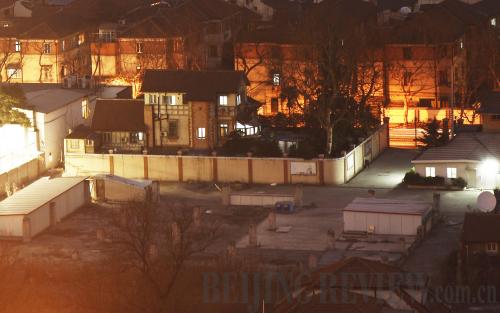|
 |
|
IDLE LAND: A piece of unused land in Shanghai's Xuhui District remains undeveloped. The property may soon be reclaimed by the government (PEI XIN) |
China's real estate developers are under pressure from land administrators taking a harder stance against idle land—land purchased for a specific project but left undeveloped for an extensive period of time. The Ministry of Land and Resources (MLR) said real estate developers that fail to develop their land in a timely manner will face high fines or have their land reclaimed by the government.
Differing from the slap-on-the-wrist notice developers received in the past, the new policy will force them into action or face the consequences of turning a deaf ear to the notifications.
Nanchang Zhengrong Properties Co. Ltd. in central China's Jiangxi Province had its land use right revoked after failing to develop 2.7 hectares of land it purchased in 2007, a public notice released by the Nanchang Bureau of Land and Resources on December 11, 2009 stated.
As of the end of December 2009, the Guangzhou Municipal Land Resources and Housing Administrative Bureau had also recalled 16 pieces of unused land totaling 43.4 hectares, some of which was sold to China's major listed property companies, including Evergrande Real Estate Group, Guangzhou R&F Properties Co. Ltd. and Gemdale Property Co. Ltd.
Also in Shanghai, eight plots of unused land totaling 66 hectares were listed for reacquisition by the government to urge the start of construction projects, said a recent announcement released by the Shanghai Municipal Bureau of Planning and Land and Resources. Among those, seven remained unused for more than two years.
Monitoring sold land that remains idle has long been on the agenda of the Chinese Government. As early as April 1999, the MLR issued Measures on Disposing Idle Land. For land left unused for one year after the agreed construction timeframe, an extra fee equivalent to 20 percent of the land transfer fee will be levied. Land that goes unused for two years after its purchase can be reclaimed by the government, the MLR measures stipulate.
The State Council and MLR have spent the last 10 years urging local authorities to impose tougher controls on idle land. In 2004, the MLR conducted a nationwide investigation of idle land incidents. Another round of investigation was conducted in 2008. In January 2008, the State Council issued a notification demanding extra fees on premium prices of idle land, especially land designated for commercial housing use.
The State Council notification also required financial institutions to be more prudent when providing loans to property developers that failed to finish one third of the total construction or one fourth of the total investment one year after contract-based construction dates were established. Governments at all levels should submit a special report on the disposal of idle lands to the State Council before the end of June 2008.
The reason behind these efforts was also due to the large amounts of land that went unused or idle. According to a 2007 China Construction Bank report, from the beginning of 2001 to May 2007, China's property developers bought almost 2.16 billion square meters of land but finished construction on only 1.29 billion square meters.
Although the Central Government has never been lenient on land hoarding, its policies and regulations failed as a result of policy neglect by local authorities. Since land transfer fees provide large revenue sources for local governments, officials were unwilling to take harsher measures against land hoarding with hopes of protecting local economic growth.
The inefficiency of local authorities' land-use administration has allowed real estate developers to scoop up large plots of land unchallenged. Currently, the country's idle land totals about 10,000 hectares, according to a recent survey of the MLR.
Coinciding with the land hoarding trend were soaring housing prices. House prices in China were all but unscathed by the economic meltdown and actually witnessed price hikes in 2009.
According to the latest statistics from the National Bureau of Statistics, house prices in China's 70 large and medium-sized cities rose 7.8 percent in December 2009 from a year earlier, and were up 1.5 percent compared to the previous month. Both year-on-year and month-on-month increases of house prices had continued for several months and the December figures were the record highs of last year.
The house price surges have prompted policymakers to tighten favorable policies, including down payment requirements and business taxes.
| 